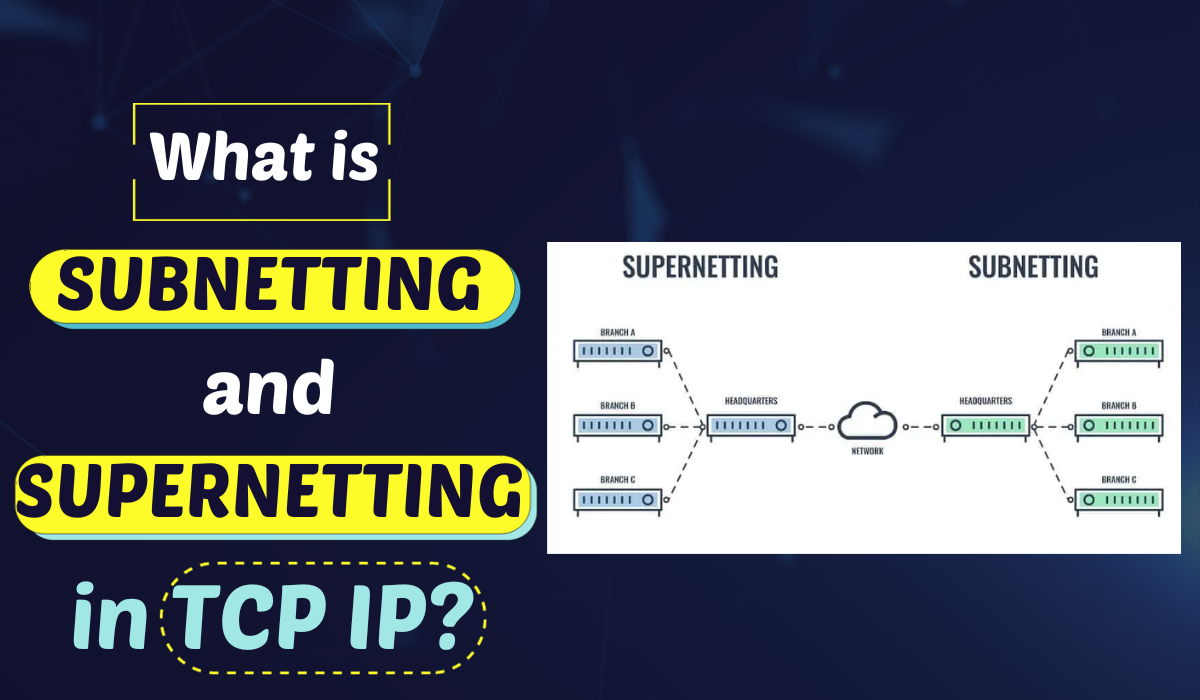In the expansive realm of computer networking, gaining a deep comprehension of the fundamental concepts of subnetting and supernetting within the context of TCP/IP is tantamount to acquiring the foundational knowledge that underpins the intricate web of the internet. In this comprehensive article, we embark on an enlightening journey, delving into the core principles of these essential networking concepts. Our aim is not only to elucidate the significance of subnetting and supernetting but also to equip you with the insights and knowledge needed to confidently address common interview questions related to TCP/IP. So, without further ado, let’s take a deep dive into the fascinating world of subnetting and supernetting, unraveling their complexities and practical applications.
Introduction to Subnetting and Supernetting
Before delving into the technical intricacies of subnetting and supernetting, let’s establish a clear foundation. Subnetting and supernetting are techniques used in TCP/IP networking to divide and aggregate IP address spaces, respectively. They play a pivotal role in optimizing network resources and enhancing network management.
What is Subnetting?
Subnetting, in essence, involves dividing a large IP network into smaller, more manageable segments. This segmentation is achieved using subnet masks, which are essential for distinguishing between the network and host portions of an IP address.
Benefits of Subnetting
Subnetting offers several advantages, such as:
- Efficient IP Address Allocation: Subnetting enables the efficient use of IP addresses, reducing wastage and ensuring optimal resource utilization.
- Enhanced Network Organization: It helps in logically organizing devices within a network, making administration and troubleshooting more straightforward.
- Improved Security: Subnets enhance network security by isolating traffic and limiting the scope of potential security breaches.
How Subnet Masks Work
Subnet masks consist of a series of binary 1s followed by binary 0s. These masks determine which portion of an IP address is the network identifier and which is the host identifier. For example, in a subnet mask of 255.255.255.0, the first 24 bits are dedicated to the network, leaving 8 bits for host addresses.
- Subnetting in Practice
Implementing subnetting involves meticulous planning and configuration. It is commonly used in scenarios where multiple departments or sub-organizations share a single IP address range but need network isolation.
What is Supernetting?
Supernetting, also known as Classless Inter-Domain Routing (CIDR), involves the aggregation of smaller IP networks into a larger one. This process simplifies routing and reduces the number of entries in routing tables.
Advantages of Supernetting
Supernetting offers several advantages:
- Reduced Routing Table Size: Supernetting reduces the size of routing tables, leading to more efficient routing.
- IP Address Conservation: It conserves IP address space by aggregating smaller networks.
CIDR Notation Demystified
CIDR notation is a compact way of representing IP addresses and their associated routing prefixes. It is expressed in the form of IP address/prefix length. For example, 192.168.0.0/16 represents a supernet with a 16-bit prefix.
Supernetting in Action
Supernetting is widely used by Internet Service Providers (ISPs) to optimize IP address allocation and routing. By aggregating IP blocks, ISPs can streamline their network infrastructure.
Subnetting vs. Supernetting
Certainly, let’s clarify the key differences between subnetting and supernetting
Subnetting:
- Breaking Down Networks: Subnetting involves breaking down a large network into smaller, more manageable parts, like dividing a big cake into smaller slices. Each slice (subnet) has its own set of connected devices.
- Efficiency and Organization: It’s like organizing a big library into sections. It helps in using IP addresses efficiently, avoids wastage, and makes managing devices easier by grouping them logically.
- Security and Isolation: Subnetting enhances security by keeping different sections of a network separate. It’s like having different rooms for different activities in a house, ensuring that one activity doesn’t disrupt another.
- Subnet Masks: To make this work, we use something called subnet masks, which are like labels that tell us which part of an IP address belongs to the network and which part belongs to devices in that network.
Supernetting:
- Combining Networks: Supernetting, on the other hand, is about combining smaller networks into a larger one, like putting several smaller boxes into a bigger box.
- Simplifying Routing: It simplifies how data moves around in a network. Instead of having to look at many small boxes, the network just looks at one big box. This makes routing faster and more efficient.
- CIDR Notation: We use something called CIDR notation to represent these larger networks in a shorter way. It’s like using code instead of writing out long addresses.
what is TCP IP
TCP/IP, short for Transmission Control Protocol/Internet Protocol, forms the foundation for internet and private network communication. Key components include:
- TCP: Ensures reliable data packet delivery, used in web browsing and email.
- IP: Addresses and routes data across networks, with IPv4 and IPv6 versions.
- IP Address: Numeric labels for devices, like 192.168.1.1, aiding data routing.
- Ports: Distinguish services on devices (e.g., web on port 80, email on port 25).
- Protocols: Rules for communication, like HTTP for web and FTP for file transfers.
- subnetting and supernetting are techniques within TCP/IP that involve dividing or aggregating IP address spaces for efficient network management.
Certainly! If you’re learning about TCP/IP, it’s essential to also explore TCP/IP interview questions These questions serve a dual purpose: they not only help you solidify your understanding of TCP/IP but also prepare you for potential interviews in the field of networking or IT.
Frequently Asked Questions
Q1: What is the main purpose of subnetting?
Subnetting aims to enhance network organization, improve security, and optimize IP address allocation.
Q2: How do I calculate subnet masks?
You can calculate subnet masks using binary operations or use online subnet mask calculators for convenience.
Q3: What is the difference between subnetting and supernetting?
Subnetting divides IP address space into smaller segments, while supernetting aggregates smaller address blocks into larger ones.
Q4: Can I use supernetting in a small network?
While supernetting is more commonly used in larger networks, it can be applied to smaller networks to simplify routing.
Q5: Where can I find more resources to learn about TCP/IP networking?
You can explore online courses, books, and networking forums to deepen your TCP/IP knowledge.
Conclusion
In summary, subnetting and supernetting are essential tools in TCP/IP networking. Subnetting divides and organizes networks, while supernetting simplifies routing. These concepts empower network administrators to make the most of their IP address resources and ensure efficient data flow. Understanding when and how to use them is key to optimizing any network.



